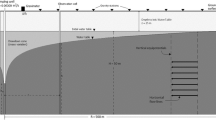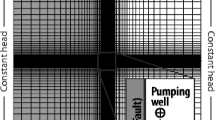Abstract
Analysis of drawdown data from pumping tests is the most common method for identification of aquifer properties and estimation of hydraulic parameters in hydrogeology. Limited hard hydraulic data from wells, expensive and intrusive, can be supplemented with geophysical spatially distributed information. Gravity, sensible to mass variations, can provide information about hydraulic parameters and storage coefficients of aquifers. A satisfactory use of gravity requires the computation of temporal evolution of gravity anomalies related with the dynamic hydraulic process. For simplified and ideal problems, the calculation can be accomplished with analytical solutions. However, the limitations of analytical solutions in capturing some relevant characteristics, like heterogeneities, that require the use of numerical models, are well known. This article shows how the time-dependent gravity anomaly caused by a pumping test can be calculated in a unique code, in a coupled manner and in a single run. The methodology avoids the use and transference of data between various codes and can be utilized in a coupled hydrogeophysical inversion procedure. Additionally, it is flexible enough to include a wide range of characteristics that can be encountered in any pumping test, and is an adequate framework for field survey planning via analysis and study of time-dependent gravity curves.












Similar content being viewed by others
References
Barlow PM, Moench AF (1999) WTAQ: a computer program for calculating drawdowns and estimating hydraulic properties for confined and water-table aquifers, Rep 99-4225, 84 pp, US Geol Surv Resour Investig, Northborough, Mass
Barlow PM, Moench AF (2011) WTAQ Version 2: a computer program for analysis of aquifer tests in confined and water-table aquifers with alternative representations of drainage from the unsaturated zone. US Geological Survey Techniques and Methods 3-B9, 41 p
Binley A, Cassian G, Deiana R (2010) Hydrogeophysics: opportunities and challenges. Boll Geofis Teor Appl 51(December):267–284
Blainey JB, Ferré TPA, Cordova JT (2007) Assessing the likely value of gravity and drawdown measurements to constrain estimates of hydraulic conductivity and specific yield during unconfined aquifer testing. Water Resour Res 43(12):W12408
Butler SL, Sinha G (2012) Forward modeling of applied geophysics methods using Comsol and comparison with analytical and laboratory analog models. Comput Geosci 42:168–176
Dagan G (1967) A method of determining the permeability and effective porosity of unconfined anisotropic aquifers. Water Resour Res 3(4):1059
Damiata BN, Lee TC (2006) Simulated gravitational response to hydraulic testing of unconfined aquifers. J Hydrol 318(1–4):348–359
Gettings P (2009) High precision gravity measurements: Techniques, Software, and Algorithms. University of Utah. http://geopotential.com/docs/UnivUtah-HighPrecisionGravityMeasurementsManual-PaulGettings.pdf. Accessed 22 December 2015
González-Quirós A, Fernández-Álvarez JP (2014) Simultaneous solving of three-dimensional gravity anomalies caused by pumping tests in unconfined aquifers. Math Geosci 46(6):649–664
Harbaugh AW, Banta ER, Hill MC, McDonald MG (2000) MODFLOW-2000, The US geological survey modular groundwater model—user guide to modularization concepts and the groundwater flow process. US Geological Survey
Herckenrath D, Auken E, Christiansen L, Behroozmand AA, Bauer-Gottwein P (2012) Coupled Hydrogeophysical inversion using time-lapse magnetic resonance sounding and time-lapse gravity data for hydraulic aquifer testing: will it work in practice? Water Resour Res. doi:10.1029/2011WR010411
Hinnell AC, Ferré TPA, Vrugt JA, Huisman JA, Moysey S, Rings J, Kowalsky MB (2010) Improved extraction of hydrologic information from geophysical data through coupled hydrogeophysical inversion. Water Resour Res. doi:10.1029/2008WR007060
Leirião S, He X, Christiansen L, Andersen OB, Bauer-Gottwein P (2009) Calculation of the temporal gravity variation from spatially variable water storage change in soils and aquifers. J Hydrol 365(3–4):302–309
Moench AF (2004) Importance of the vadose zone in analyses of unconfined aquifer tests. Ground Water 42:223–233
Neuman SP (1972) Theory of flow in unconfined aquifers considering delayed gravity response. Water Resour Res 8(4):1031–1045
Neuman SP (1974) Effects of partial penetration on flow in unconfined aquifers considering delayed aquifer response. Water Resour Res 10:303–312
Rubin Y, Hubbard SS (eds) (2005) Hydrogeophysics. Springer, The Netherlands
Scintrex Limited (2009) CG-5 Scintrex Autograv system. Operation Manual, Ontario, Canada
Telford WM, Geldart LP, Sheriff RE (1990) Applied geophysics. Cambridge University Press, New York
Theis CV (1935) The relation between the lowering of the piezometric surface and the rate and duration of discharge of a well using ground water storage. In: Transactions, American Geophysical Union, 16th annual meeting, part 2, pp 519–524
Zhao C (2009) Dynamic and transient infinite elements: theory and geophysical, geotechnical and geoenvironmental applications. Springer, Berlin
Acknowledgments
Andrés González-Quirós has been supported by the Mathematical Geosciences Student Award 2014. We thank the anonymous reviewers for their detailed comments and suggestions, which helped us to improve the manuscript.
Author information
Authors and Affiliations
Corresponding author
Rights and permissions
About this article
Cite this article
González-Quirós, A., Fernández-Álvarez, J.P. Forward Coupled Modeling and Assessment of Gravity Anomalies Caused by Pumping Tests in Unconfined Aquifers Under Unsteady-State Conditions. Math Geosci 49, 603–617 (2017). https://doi.org/10.1007/s11004-016-9634-1
Received:
Accepted:
Published:
Issue Date:
DOI: https://doi.org/10.1007/s11004-016-9634-1




